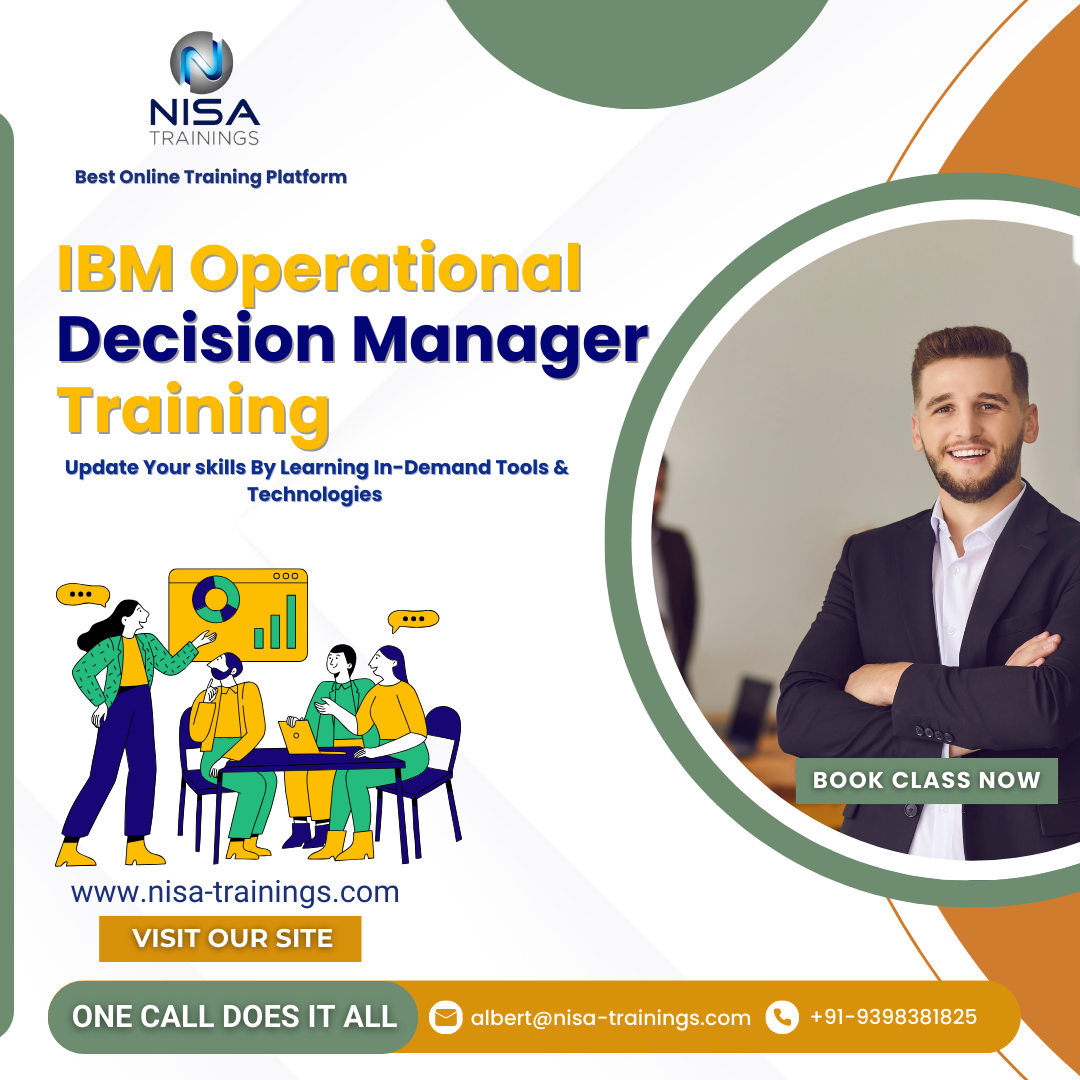IBM Operational Decision Manager Training

Why should you choose NisaFor IBM Operational Decision Manager Training?
Nisa Trainings is the best online training platform for conducting one-on-one interactive live sessions with a 1:1 student-teacher ratio. You can gain hands-on experience by working on near-real-time projects under the guidance of our experienced faculty. We support you even after the completion of the course and happy to clarify your doubts anytime. Our teaching style at Nisa Trainings is entirely hands-on. You’ll have access to our desktop screen and will be actively conducting hands-on labs on your desktop.
Job Assistance
If you face any problem while working on IBM Operational Decision Manager Course, then Nisa Trainings is simply a Call/Text/Email away to assist you. We offer Online Job Support for professionals to assist them and to solve their problems in real-time.
The Process we follow for our Online Job Support Service:
- We receive your inquiry for Online Job
- We will arrange a telephone call with our consultant to grasp your complete requirement and the tools you’re
- If our consultant is 100% confident in taking up your requirement and when you are also comfortable with our consultant, we will only agree to provide service. And then you have to make the payment to get the service from
- We will fix the timing for Online Job Support as mutually agreed by you and our consultant.
Course Information
IBM Operational Decision Manager Training
Duration: 25 Hours
Timings: Weekdays (1-2 Hours per day) [OR] Weekends (2-3 Hours per day)
Training Method: Instructor Led Online One-on-One Live Interactive
Sessions.
COURSE CONTENT :
1. Introduction to IBM Operational Decision Manager (ODM)
- Overview of IBM ODM:
- What is IBM ODM?
- Benefits and applications of ODM
- Key features (Business Rules, Decision Automation, CEP, Analytics)
- High-level architecture of ODM
- Understanding the role of decision automation in business processes
- ODM Use Cases:
- Examples from industries like finance, healthcare, retail, and telecommunications.
2. IBM ODM Architecture and Components
- Core Components:
- Decision Server (rule execution engine)
- Decision Center (management interface for rules and policies)
- Rule Execution Server (runtime component)
- Rule Authoring Tools (Decision Designer, Rule Designer)
- Understanding Decision Services:
- What are decision services?
- How ODM integrates into an enterprise IT architecture
- Defining decision logic, decision flows, and decision tables
- Deployment & Integration:
- Integration with other IBM products (e.g., IBM BPM, IBM Cloud)
- RESTful APIs for decision service consumption
- Embedding ODM into applications and workflows
3. Working with Business Rules in ODM
- Business Rule Authoring:
- Rule creation, testing, and deployment
- Defining decision logic with Decision Tables, Decision Trees, and Rule Flows
- Writing and debugging rules using IBM ODM Designer
- Rule Management and Governance:
- Versioning and rule lifecycle management
- Rule policies and governance best practices
- Auditing rules and decision outcomes
- Testing and Simulation:
- Simulating rule execution
- Using Decision Center for rule testing and analysis
- Troubleshooting and debugging business rules
4. Decision Automation and Business Logic
- Automating Business Decisions:
- Creating decision flows and automating decisions
- Defining decision requirements and thresholds
- Using business rules to implement real-time decision-making
- Decision Services:
- How to create reusable decision services
- Defining decision points in workflows and processes
- Publishing and invoking decision services
- Business Rule Management vs. Decision Management:
- Difference between business rules and full decision management
- How business decisions interact with other systems (e.g., BPM, CRM)
5. Advanced Rule Modeling Techniques
- Decision Trees and Decision Tables:
- Creating complex decision models
- Using decision tables to handle multiple conditions
- Complex Event Processing (CEP):
- Introduction to CEP in ODM
- Setting up event-driven decision-making
- Processing streams of events and triggering decisions in real time
- Machine Learning and Predictive Analytics:
- Integrating predictive models with ODM
- Leveraging historical data to enhance decision-making
- Training and deploying machine learning models for decision optimization
6. Integrating ODM with Other Applications and Systems
- Integration with Web and Cloud Applications:
- Using REST APIs to invoke decision services
- Integrating ODM with IBM Cloud, BPM, and other enterprise solutions
- Using ODM with External Data Sources:
- Integrating ODM with databases, APIs, and external services
- Handling dynamic and real-time data inputs
- Connecting ODM to BPM and Workflow Solutions:
- Embedding business rules into BPM processes
- Automating workflows using decision services and business rules
7. Decision Center and Operational Control
- Using Decision Center for Business Users:
- How business users can create, edit, and test rules
- Managing business rule lifecycles and versions
- Rule Governance and Compliance:
- Ensuring regulatory compliance through rule transparency
- Managing policies and governance for decision automation
- Audit and Monitoring of Decision Services:
- Tracking decisions, rule executions, and outcomes
- Real-time monitoring and reporting tools
- Creating reports to ensure business decisions align with organizational policies
8. Performance Tuning and Scalability
- Optimizing Rule Execution:
- Strategies for improving rule execution speed
- Caching and optimization techniques
- Scaling ODM:
- Best practices for scaling ODM to handle large volumes of data
- Load balancing, failover, and fault tolerance
- Performance tuning of Decision Server and Rule Execution Server
9. Real-World Use Cases and Implementation Examples
- Industry-Specific Examples:
- Examples of ODM implementations in industries such as banking (fraud detection), healthcare (patient care decisions), and retail (dynamic pricing)
- Best Practices:
- Best practices for rule management and decision automation
- Implementing effective decision models and managing them over time
- Case Study Review:
- Walkthrough of successful ODM implementations
- Challenges and lessons learned from real-world projects

